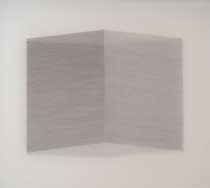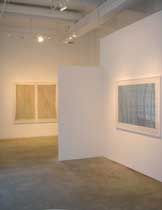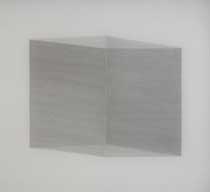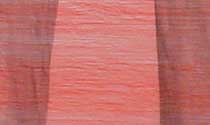Post by Douglas Witmer

[ed. Note: this is part two of the Douglas Witmer-Linn Meyers email conversation that began yesterday on Artblog. Here, Meyers talks about building a drawing, about the rhythm of her day in the studio and about her works’ relationship to that of Agnes Martin. Read part one here.]
DW You work with a very defined set of approaches to mark making. Any of these approaches, in the accumulative way that you employ them, feel to me like they could go on forever. I’m interested in finding out how you come to define the beginnings and ends of these processes resulting in a finished work. (top image is “200461” from the artist’s Gallery Joe exhibit, up through July 2.)
LM Usually the drawing that I am [at work] on will give me an idea for the next drawing, and I usually start another one before the first is finished. Sometimes I have a whole list of ideas that I want to work down.

So I’ll roll out a piece of Mylar that size, and get started. Sometimes the drawing works the way I expect it to work. If all goes as planned, the composition develops within the margins of the cut Mylar. But sometimes in the middle of a drawing I see something developing that needs more space, and I will go beyond the original size by splicing another piece of Mylar to the first piece, or by overlapping the first piece of Mylar on top of another piece. There’s one drawing on my website (I think it’s the 4th one down on the portfolio page) where I started with one piece of Mylar that was about 42″x62″, and I ended up adding 5 more pieces that size. That drawing ended up being 10 ft x 11 ft. It just needed room to breathe. (image is detail of “Untitled 2004”)

It is important to me that the images have a clearly defined ending. Because they are pattern-based, I always fear that they will look like wallpaper if they don’t have defined edges. Where the drawing ends is where it ends — I don’t want them to be understood as fragments. They are defined periods of time.
(image is installation shot from Gallery Joe)
Daily rhythms and sneaking studio time on the weekend
DW What is a typical day in your studio like? What work patterns do you find yourself falling into? Are there activities in the periphery like music, reading, family, etc?
LM My studio is in a building behind our house, so my commute is only about 150 feet. I have always had a hard time getting started in the morning, though.
When I used to rent a studio that was separate from our home I found it easy to get there but more difficult to get started once I arrived. I would usually spend an hour or so reading when I arrived.

Nowadays I start by clearing deskwork and answering or sending e-mail. Then I walk out to the studio (I sometimes pull weeds or poke at the plants along the path as I go out there,) and read for a few minutes, and then I begin to draw. (image is “200461b”)
I have a hard time listening to music while I work because many of my drawings require that I count, and the music creates a weird distraction from that counting. So I usually listen to NPR, or work in silence. I screen a lot of phone calls.
Once I get going, I can usually draw for 1 and a half – 4 hours without taking a break. When my hand or my eyes get tired, I either spend a little time reading or I come inside the house to check my e-mail or get a snack. My workday is generally from about 9 to 4:30, weekdays. Two or three times a week I get back out to the studio at night for a couple of hours. Sometimes I sneak a little time in over the weekend.
Measuring the inner landscape

DW I assume Agnes Martin comes up a lot when people talk about your work. There is a superficial visual relationship. And it seems there is a shared reverence for nature. But when you were describing the development of your work from “landscape” early on towards the abstraction that you currently make, what immediately popped into my head was Jackson Pollock‘s famous quote: “I am nature.” And then in your description of your work, I found myself thinking of the films of him working outside and what an incredibly even rhythmic meter there was to his movement in those films. Shifting back to your work, I thought about the album cover of Joy Division‘s “Unknown Pleasures.” It features a graphic recording of the light pulses from the first discovered pulsar. Then the idea of your work as a graphic recording of the “emotional tremors” constantly happening within came to mind. And then I said to myself: “inner seismograph.” How does this strike you as it relates to your work?
LM I LOVE THAT!! As far as Pollock’s quote, I sort of believe in the inter-connectedness of everything and everyone. “Everything matters,” to quote the Gallery Joe exhibition title.
As far as Agnes is concerned, you should know that I do love her work. There are many big differences. One difference that I think is undeniable is that she was attempting to make paintings about pure joy and I can’t do that. When I draw I am interested in recording the full range of human experience: chaos, love, insecurity, joy, etc. (last image is detail of “Untitled 2004”)
–Douglas Witmer is an artist, blogger and artblog contributor.









